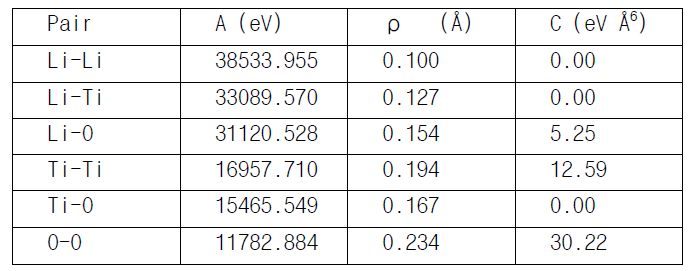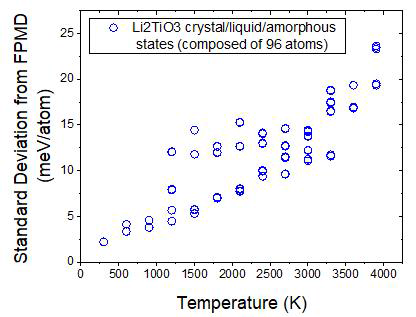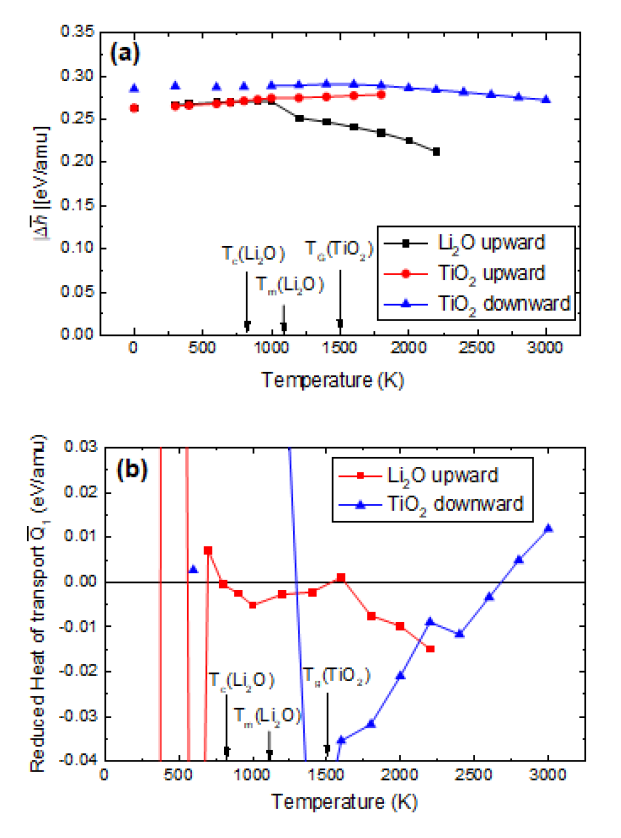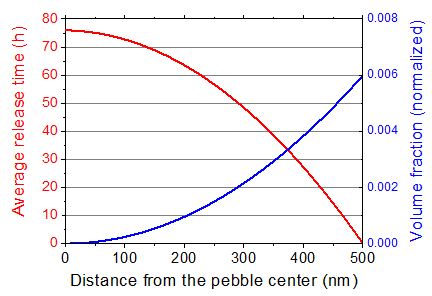최소 단어 이상 선택하여야 합니다.
최대 10 단어까지만 선택 가능합니다.
SAI
다음과 같은 기능을 한번의 로그인으로 사용 할 수 있습니다.
NTIS 바로가기
다음과 같은 기능을 한번의 로그인으로 사용 할 수 있습니다.
DataON 바로가기
다음과 같은 기능을 한번의 로그인으로 사용 할 수 있습니다.
Edison 바로가기
다음과 같은 기능을 한번의 로그인으로 사용 할 수 있습니다.
Kafe 바로가기
| 주관연구기관 | 서울대학교 Seoul National University |
|---|---|
| 연구책임자 | Takuji Oda |
| 보고서유형 | 최종보고서 |
| 발행국가 | 대한민국 |
| 언어 | 한국어 |
| 발행년월 | 2020-02 |
| 과제시작연도 | 2019 |
| 주관부처 | 과학기술정보통신부 Ministry of Science and ICT |
| 연구관리전문기관 | 한국연구재단 National Research Foundation of Korea |
| 등록번호 | TRKO202100001844 |
| 과제고유번호 | 1711081581 |
| 사업명 | 핵융합기초연구(R&D) |
| DB 구축일자 | 2021-06-19 |
| 키워드 | 삼중수소 증식재.방사선 효과.방사선 손상.핵융합로.핵융합 블랭킷.tritium breeder.radiation effects.radiation damage.fusion reactors.fusion blanket. |
연구의 목적 및 내용
핵융합로의 안전하고 지속가능한 삼중수소 연료주기를 달성하기 위해서는 운전 중 14 MeV 중성자에 의한 삼중수소 증식재의 재료물성 변화를 예측하는 것이 중요하다. 하지만 아직 이에 대한 연구는 미진한 상황이다. 결과적으로 핵융합로 블랭킷은 선행 연구에 대한 철저한 검토가 다소 부족한 채로 설계되어 왔으며, 블랭킷의 장기 내구성 및 성능에 대한 우려가 현존한다. 본 연구에서는 멀티스케일 모델링을 이용하여, 유망한 삼중수소 증식재 (Li2TiO3)의 핵융합로 운전 중 재
연구의 목적 및 내용
핵융합로의 안전하고 지속가능한 삼중수소 연료주기를 달성하기 위해서는 운전 중 14 MeV 중성자에 의한 삼중수소 증식재의 재료물성 변화를 예측하는 것이 중요하다. 하지만 아직 이에 대한 연구는 미진한 상황이다. 결과적으로 핵융합로 블랭킷은 선행 연구에 대한 철저한 검토가 다소 부족한 채로 설계되어 왔으며, 블랭킷의 장기 내구성 및 성능에 대한 우려가 현존한다. 본 연구에서는 멀티스케일 모델링을 이용하여, 유망한 삼중수소 증식재 (Li2TiO3)의 핵융합로 운전 중 재료물성 변화에 관한 이론적인 모델을 확립하고 이를 예측하고자 하였다.
연구 개발 성과
3년 동안 다음 세 가지 주제를 연구하였다. 결과적으로, 삼중수소 증식재로 사용되는 Li2TiO3의 4가지 중요한 재료 특성을 예측하기 위한 모델을 방사선 효과를 포함하여 성공적으로 개발하였다. 이 모델은 핵융합로의 시간 및 온도 등과 같이 주어진 조건에서 재료의 특성을 결정할 수 있게 한다.
○ [주제-1: Li2TiO3 의 재료 특성 계산 방법 구축] Li2TiO3의 구조적, 기계적, 및 열적인 특성을 정확하게 결정하는 방법을 개발하였다. 구체적으로는, 다양한 조건에 대한 열전도도를 결정하기 위해 새로운 퍼텐셜 모델을 구축하였고 방법의 이론적 신뢰도를 개선하였다. 또한, 삼중수소 재고량을 결정하는 모델을 제안하였다.
○ [주제-2: Li2TiO3의 방사선 손상 거동 모델링] 임계 변위 에너지를 결정하였다. 또한, 최대 100 keV까지 방사선 결함 형성 거동을 체계적으로 점검하였다. 그리고 결함 복구를 위한 반응 경로 분석을 통해, 삼중수소 증식재에서 Li burn-up에 의해 유발된 anti-site 결함 (LiTi와 TiLi) 및 Li2O 손실이 중요한 역할을 한다는 것을 확인했다. 마지막으로, 핵융합 환경에서 이 두 가지 결함의 농도 변화를 예측하기 위한 모델을 구축하였다.
○ [주제-3: 방사선 환경 하에서의 Li2TiO3 재료 특성 변화 예측] 먼저 결함이 재료 특성을 어떻게 변화시키는지를 결함 농도의 함수로서 결정하였다. 개발된 결함 발달 모델과 결합하여, 최종적으로 핵융합로 운전 시간의 함수로서 재료 특성 변화를 예측하는 모델을 구축하였다.
연구 개발 성과의 활용 계획 (기대 효과)
(1) 본 과제를 통해 확보한 이론적 모델은 핵융합로 블랭킷의 설계와 삼중수소 연료주기의 지속가능성 향상을 가능하게 한다. 추가적으로 이 모델은 삼중수소의 방사선 문제와 관련하여 증식용 블랭킷의 라이센싱과 안전 규제에 필요한 과학적인 기반을 강화한다.
(2) 모델이 원자단위 계산결과에 근거하기 때문에, 재료물성과 방사선 효과에 관한 전반적인 과학적인 이해가 깊다. 이러한 과학적 이해는 더 나은 후보 증식재를 찾는데 도움을 줄 것이다. 예를 들어, 본 모델이 “삼중수소의 축적”을 재료물성의 가장 중대한 문제점이라고 예측한다면, 연구역량을 방사선 손상으로 삼중수소 축적이 최소한으로 일어나는 재료를 찾는 데에 집중할 수 있다.
(3) 본 과제에서 사용된 계산적 방법론은 손쉽게 다른 후보 증식재군 (예를 들면 as Li4SiO4)에 적용될 수 있다. 따라서 이는 방사선 손상효과를 고려한 증식재 선정에 사용될 수 있다.
(4) 현재 한국 뿐 아니라 전 세계적으로도 증식재에 대한 방사선 효과를 평가하는 모델이 없기 때문에, 본 과제는 핵융합 R&D의 국제적인 협력 사업에 역시 크게 기여할 것이다.
(출처 : 요약문 4p)
Purpose & Contents
In order to establish a safe and sustainable tritium fuel cycle in fusion reactors, it is important to predict how 14 MeV neutron irradiation affect properties of tritium breeding materials during the reactor operation. However, quite less is known on the radiation effects. Con
Purpose & Contents
In order to establish a safe and sustainable tritium fuel cycle in fusion reactors, it is important to predict how 14 MeV neutron irradiation affect properties of tritium breeding materials during the reactor operation. However, quite less is known on the radiation effects. Consequently, the fusion blanket has been designed without considering the radiation effects in previous studies, which may cause serious problems in the long-term performance of the blanket. In this project, therefore, using multi-scale modeling techniques, we aimed to construct a theoretical model to predict how material properties (elastic constants, volume, thermal conductivity and tritium inventory) of Li2TiO3 will change during the operation of fusion reactors.
Results
We have researched the following three research topics over 3 years. Consequently, we have successfully developed models to predict the four important material properties of Li2TiO3 as tritium breeder, including radiation effects on the properties.
These models allow to determine properties at given conditions such as time and temperature for a given fusion reactor.
○ [Subject-1: Establishment of calculation methods for material properties of Li2TiO3] We developed methods to determine structural, mechanical, and thermal properties of Li2TiO3 accurately. Specifically, we have constructed a new potential model and improved the theoretical reliability of a method to determine thermal conductivity for various conditions. In addition, we proposed a model to determine tritium inventory.
○ [Subject-2: Modeling of radiation damage behavior of Li2TiO3] We have determined threshold displacement energies. In addition, up to 100 keV, we have systematically checked the radiation damage formation behaviors. In addition, through reaction path analysis for defect recovery, we have identified anti-site defects (LiTi and TiLi) and Li2O-loss caused by Li brun-up for tritium breeding play key roles.
Finally we have constructed a model to pursue the concentration changes of these two defects under a nuclear fusion environment.
○ [Subject-3: Prediction of material property changes of Li2TiO3 under radiation environment] We have first determined how the defects change the material properties as a function of the defect concentrations. Combining with the developed defect evolution model, we have finally constructed models to predict the material property changes as function of fusion reactor operation time.
Expected Contribution
(1) The developed theoretical model facilitates the design of the breeding blanket and the evaluation of the sustainability of the tritium fuel cycle. The model also reinforces the scientific basis for licensing and safety regulation of the breeding blanket regarding tritium radiation safety.
(2) As the model was constructed from an atomic scale, scientific details of material properties and radiation effects were obtained. The scientific details help us effectively develop new materials. For example, if the model indicate that the tritium inventory is a key problem, we can focus our efforts to find a new material whose tritium inventory is less affected by radiation.
(3) The computational approach extended in this project can be applied to other candidate materials such as Li4SiO4. Thus, it can be used for selection of the breeding material with considering effects of radiation damages.
(4) Because there is no similar model to evaluate the radiation effects on the properties of breeding materials in the world, the results of this project will largely contributed to the international collaboration for fusion energy.
(출처 : SUMMARY 5p)
 표
Model parameters in Vijayakumar model for Li2TiO3. qLi, qTi, and qO are +0.549e, +2.196e, and –1.098e, respectively, where e represents the elementary charge. The cutoff distance (for the second and third terms in Eq.3.1.3-1) is 10Å. The Coulomb interaction (the first term in Eq. 3.1.3-1) is evaluated using Ewald summation method (by particle-particle particle-mesh solver version, PPPM, in LAMMPS) without cutoff
표
Model parameters in Vijayakumar model for Li2TiO3. qLi, qTi, and qO are +0.549e, +2.196e, and –1.098e, respectively, where e represents the elementary charge. The cutoff distance (for the second and third terms in Eq.3.1.3-1) is 10Å. The Coulomb interaction (the first term in Eq. 3.1.3-1) is evaluated using Ewald summation method (by particle-particle particle-mesh solver version, PPPM, in LAMMPS) without cutoff
 표
Direct comparison between energies obtained by PM-CS and obtained by FPMD for Li2TiO3 systems composed of 96 atoms in 300-3900 K. Solid/amorphous/liquid states are contained. The energies are given as per-system quantities (not per-atom). The red line represents the condition where the potential model gives the same value with the FPMD
표
Direct comparison between energies obtained by PM-CS and obtained by FPMD for Li2TiO3 systems composed of 96 atoms in 300-3900 K. Solid/amorphous/liquid states are contained. The energies are given as per-system quantities (not per-atom). The red line represents the condition where the potential model gives the same value with the FPMD
 표
Standard deviation of energies calculated by PM-CS from those calculated by FPMD as a function of the system temperature. The scattering of data points at around 1500-2000 K comes from the fact that data of both solid (lower deviation cases) and amorphous (higher deviation cases) states are included in these temperatures
표
Standard deviation of energies calculated by PM-CS from those calculated by FPMD as a function of the system temperature. The scattering of data points at around 1500-2000 K comes from the fact that data of both solid (lower deviation cases) and amorphous (higher deviation cases) states are included in these temperatures
 표
Structural parameters calculated by CMS with PM-VK and PM-CS. As reference data, reported first-principles calculation results and experimental results are compared. Note that the three calculation results (PM-VK, PM-CS and FPMS) are of static calculation results, where the system temperature is 0 K in a classical sense and thus the zero-point vibration effect is not included, while the experimental data was obtained at room temperature (295 K). The pressure is 1 atm in the experiment and 0 Pa in the simulations. Note this pressure difference does not significantly change structural parameters and elastic constants is solid ceramics as ceramics are hard. The value inside the parenthesis for each calculation result is the difference from the experimental value
표
Structural parameters calculated by CMS with PM-VK and PM-CS. As reference data, reported first-principles calculation results and experimental results are compared. Note that the three calculation results (PM-VK, PM-CS and FPMS) are of static calculation results, where the system temperature is 0 K in a classical sense and thus the zero-point vibration effect is not included, while the experimental data was obtained at room temperature (295 K). The pressure is 1 atm in the experiment and 0 Pa in the simulations. Note this pressure difference does not significantly change structural parameters and elastic constants is solid ceramics as ceramics are hard. The value inside the parenthesis for each calculation result is the difference from the experimental value
 표
(수식) Temperature dependence of (a) and (b) . Tc, Tm and Tg indicate the superionicity transition temperature, the melting point and the glass-transition temperature, respectively. The absolute value of is about one order of magnitude larger than the absolute value of in both the Li2O and TiO2 model systems
표
(수식) Temperature dependence of (a) and (b) . Tc, Tm and Tg indicate the superionicity transition temperature, the melting point and the glass-transition temperature, respectively. The absolute value of is about one order of magnitude larger than the absolute value of in both the Li2O and TiO2 model systems
 표
Average release time needed to be released for T generated at 900 K in Li2TiO3 as a function of the distance between the center and where T is generated in a spherical grain of 1 μm diameter (0.5 μm radius). The diffusion coefficient was obtained by Eq. 3.3.6-1. The right axis shows the volume fraction at a given distance, which is proportional to the fraction of T generated at the distance
표
Average release time needed to be released for T generated at 900 K in Li2TiO3 as a function of the distance between the center and where T is generated in a spherical grain of 1 μm diameter (0.5 μm radius). The diffusion coefficient was obtained by Eq. 3.3.6-1. The right axis shows the volume fraction at a given distance, which is proportional to the fraction of T generated at the distance
 표
Defect identification method using Wigner-Seitz (WS) method (voronoi method). First, with respect to the perfect crystal, the WS cells are constructed (“Perfect structure”). In this explanation, for simplicity, two constituent atoms (red and blue) are considered. During and after collision simulations, with keeping the cells fixed, defect structures are identified. For example, “Vacancy” is observed as a WS cell that does not contain any atoms. “Interstitial” is observed as a WS cell that contains multiple atoms (mostly 2). “Anti-site (defect)” is observed as a WS cell that contains a different atom (a WS cell of red atom contains a blue atom, in this example)
표
Defect identification method using Wigner-Seitz (WS) method (voronoi method). First, with respect to the perfect crystal, the WS cells are constructed (“Perfect structure”). In this explanation, for simplicity, two constituent atoms (red and blue) are considered. During and after collision simulations, with keeping the cells fixed, defect structures are identified. For example, “Vacancy” is observed as a WS cell that does not contain any atoms. “Interstitial” is observed as a WS cell that contains multiple atoms (mostly 2). “Anti-site (defect)” is observed as a WS cell that contains a different atom (a WS cell of red atom contains a blue atom, in this example)
 표
Model parameters in Vijayakumar model for Li2TiO3. qLi, qTi, and qO are +0.549e, +2.196e, and –1.098e, respectively, where e represents the elementary charge. The cutoff distance (for the second and third terms in Eq.3.1.3-1) is 10Å. The Coulomb interaction (the first term in Eq. 3.1.3-1) is evaluated using Ewald summation method (by particle-particle particle-mesh solver version, PPPM, in LAMMPS) without cutoff
표
Model parameters in Vijayakumar model for Li2TiO3. qLi, qTi, and qO are +0.549e, +2.196e, and –1.098e, respectively, where e represents the elementary charge. The cutoff distance (for the second and third terms in Eq.3.1.3-1) is 10Å. The Coulomb interaction (the first term in Eq. 3.1.3-1) is evaluated using Ewald summation method (by particle-particle particle-mesh solver version, PPPM, in LAMMPS) without cutoff
 표
Direct comparison between energies obtained by PM-CS and obtained by FPMD for Li2TiO3 systems composed of 96 atoms in 300-3900 K. Solid/amorphous/liquid states are contained. The energies are given as per-system quantities (not per-atom). The red line represents the condition where the potential model gives the same value with the FPMD
표
Direct comparison between energies obtained by PM-CS and obtained by FPMD for Li2TiO3 systems composed of 96 atoms in 300-3900 K. Solid/amorphous/liquid states are contained. The energies are given as per-system quantities (not per-atom). The red line represents the condition where the potential model gives the same value with the FPMD
 표
Standard deviation of energies calculated by PM-CS from those calculated by FPMD as a function of the system temperature. The scattering of data points at around 1500-2000 K comes from the fact that data of both solid (lower deviation cases) and amorphous (higher deviation cases) states are included in these temperatures
표
Standard deviation of energies calculated by PM-CS from those calculated by FPMD as a function of the system temperature. The scattering of data points at around 1500-2000 K comes from the fact that data of both solid (lower deviation cases) and amorphous (higher deviation cases) states are included in these temperatures
 표
Structural parameters calculated by CMS with PM-VK and PM-CS. As reference data, reported first-principles calculation results and experimental results are compared. Note that the three calculation results (PM-VK, PM-CS and FPMS) are of static calculation results, where the system temperature is 0 K in a classical sense and thus the zero-point vibration effect is not included, while the experimental data was obtained at room temperature (295 K). The pressure is 1 atm in the experiment and 0 Pa in the simulations. Note this pressure difference does not significantly change structural parameters and elastic constants is solid ceramics as ceramics are hard. The value inside the parenthesis for each calculation result is the difference from the experimental value
표
Structural parameters calculated by CMS with PM-VK and PM-CS. As reference data, reported first-principles calculation results and experimental results are compared. Note that the three calculation results (PM-VK, PM-CS and FPMS) are of static calculation results, where the system temperature is 0 K in a classical sense and thus the zero-point vibration effect is not included, while the experimental data was obtained at room temperature (295 K). The pressure is 1 atm in the experiment and 0 Pa in the simulations. Note this pressure difference does not significantly change structural parameters and elastic constants is solid ceramics as ceramics are hard. The value inside the parenthesis for each calculation result is the difference from the experimental value
 표
(수식) Temperature dependence of (a) and (b) . Tc, Tm and Tg indicate the superionicity transition temperature, the melting point and the glass-transition temperature, respectively. The absolute value of is about one order of magnitude larger than the absolute value of in both the Li2O and TiO2 model systems
표
(수식) Temperature dependence of (a) and (b) . Tc, Tm and Tg indicate the superionicity transition temperature, the melting point and the glass-transition temperature, respectively. The absolute value of is about one order of magnitude larger than the absolute value of in both the Li2O and TiO2 model systems
 표
Average release time needed to be released for T generated at 900 K in Li2TiO3 as a function of the distance between the center and where T is generated in a spherical grain of 1 μm diameter (0.5 μm radius). The diffusion coefficient was obtained by Eq. 3.3.6-1. The right axis shows the volume fraction at a given distance, which is proportional to the fraction of T generated at the distance
표
Average release time needed to be released for T generated at 900 K in Li2TiO3 as a function of the distance between the center and where T is generated in a spherical grain of 1 μm diameter (0.5 μm radius). The diffusion coefficient was obtained by Eq. 3.3.6-1. The right axis shows the volume fraction at a given distance, which is proportional to the fraction of T generated at the distance
 표
Defect identification method using Wigner-Seitz (WS) method (voronoi method). First, with respect to the perfect crystal, the WS cells are constructed (“Perfect structure”). In this explanation, for simplicity, two constituent atoms (red and blue) are considered. During and after collision simulations, with keeping the cells fixed, defect structures are identified. For example, “Vacancy” is observed as a WS cell that does not contain any atoms. “Interstitial” is observed as a WS cell that contains multiple atoms (mostly 2). “Anti-site (defect)” is observed as a WS cell that contains a different atom (a WS cell of red atom contains a blue atom, in this example)
표
Defect identification method using Wigner-Seitz (WS) method (voronoi method). First, with respect to the perfect crystal, the WS cells are constructed (“Perfect structure”). In this explanation, for simplicity, two constituent atoms (red and blue) are considered. During and after collision simulations, with keeping the cells fixed, defect structures are identified. For example, “Vacancy” is observed as a WS cell that does not contain any atoms. “Interstitial” is observed as a WS cell that contains multiple atoms (mostly 2). “Anti-site (defect)” is observed as a WS cell that contains a different atom (a WS cell of red atom contains a blue atom, in this example)
해당 보고서가 속한 카테고리에서 활용도가 높은 상위 5개 콘텐츠를 보여줍니다.
더보기 버튼을 클릭하시면 더 많은 관련자료를 살펴볼 수 있습니다.
| 과제명(ProjectTitle) : | - |
|---|---|
| 연구책임자(Manager) : | - |
| 과제기간(DetailSeriesProject) : | - |
| 총연구비 (DetailSeriesProject) : | - |
| 키워드(keyword) : | - |
| 과제수행기간(LeadAgency) : | - |
| 연구목표(Goal) : | - |
| 연구내용(Abstract) : | - |
| 기대효과(Effect) : | - |
| 내보내기 구분 |
|
|---|---|
| 구성항목 |
관리번호, 제목(한글), 저자명(한글), 발행일자, 전자원문, 초록(한글), 초록(영문) 관리번호, 제목(한글), 제목(영문), 저자명(한글), 저자명(영문), 주관연구기관(한글), 주관연구기관(영문), 발행일자, 총페이지수, 주관부처명, 과제시작일, 보고서번호, 과제종료일, 주제분류, 키워드(한글), 전자원문, 키워드(영문), 입수제어번호, 초록(한글), 초록(영문), 목차 |
| 저장형식 |
|
| 메일정보 |
|
| 안내 |
총 건의 자료가 검색되었습니다. 다운받으실 자료의 인덱스를 입력하세요. (1-10,000) 검색결과의 순서대로 최대 10,000건 까지 다운로드가 가능합니다. 데이타가 많을 경우 속도가 느려질 수 있습니다.(최대 2~3분 소요) 다운로드 파일은 UTF-8 형태로 저장됩니다. ~ |
Copyright KISTI. All Rights Reserved.
AI-Helper는 오픈소스 모델을 사용합니다. 사용하고 있는 오픈소스 모델과 라이센스는 아래에서 확인할 수 있습니다.
AI-Helper uses Open Source Models. You can find the source code of these open source models, along with applicable license information below. (helpdesk@kisti.re.kr)
OpenAI의 API Key를 브라우저에 등록하여야 ChatGPT 모델을 사용할 수 있습니다.
등록키는 삭제 버튼을 누르거나, PDF 창을 닫으면 삭제됩니다.

※ AI-Helper는 부적절한 답변을 할 수 있습니다.